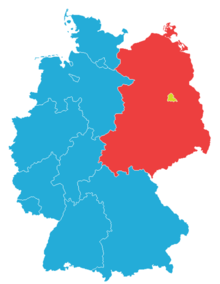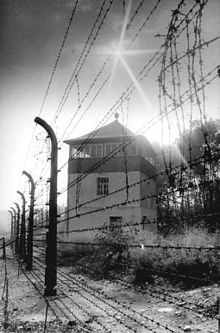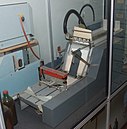This is an old revision of this page, as edited by CeeGee (talk | contribs) at 08:25, 6 February 2014 (added Category:History of East Germany using HotCat). The present address (URL) is a permanent link to this revision, which may differ significantly from the current revision.
Revision as of 08:25, 6 February 2014 by CeeGee (talk | contribs) (added Category:History of East Germany using HotCat)(diff) ← Previous revision | Latest revision (diff) | Newer revision → (diff)| The neutrality of this article is disputed. Relevant discussion may be found on the talk page. Please do not remove this message until conditions to do so are met. (Learn how and when to remove this message) |

Mass surveillance in East Germany was a widespread practice throughout the country's history, involving Soviet, East German, and Western agencies.
Background

East Germany, known formally as the "German Democratic Republic" or the "Deutsche Demokratische Republik", was an Eastern bloc state from 1949 to 1990. Its territory consisted of the region of Germany that had been controlled by Soviet forces at the end of World War Two.
Penalties for unapproved political contacts were most severe. Though initially those sent to the NKVD special camps in Germany (1945-1949) were largely interned members of the Nazi party or the juvenile Werwolf, sentenced inmates came to include many supporters of the Social Democratic Party of Germany (SPD), which became the focus of Soviet authorities in 1946. When the Social Democratic Party was merged into the Communist Party of Germany (KPD), renamed Socialist Unity Party of Germany (SED), Social Democrats were interned to ensure Stalinist dominance in the party. Also, people were interned as "spies" for suspected opposition to the authoritarian regime, e.g. for contacts to organizations based in the Western occupation zones, on the basis of Article 58 of the Soviet penal code dealing with "anti-Soviet activities".
Of 123,000 Germans and 35,000 others held in the NKVD special camps, 43,000 perished. Of the 10,000 youths and children interned, half did not return.
Soviet surveillance
In 1947, the Soviet Military Administration in Germany (SMAD) issued Order No. 201, which established a fifth organization of Eastern German police, called Kommissariat 5 (K-5). The mission of K-5 was primarily to conduct surveillance of individuals in East Germany, especially those in East German governing bodies. While nominally controlled by the young East German government, in practice, K-5 operated as a sub-unit of the Soviet KGB. Most of K-5's cases came from the KGB, and KGB officers were present through the organization. KGB officers were involved in day-to-day K-5 operations like training and interrogations.
Domestic surveillance

 In Department M, mail was opened with a hot air blower (left), inspected, then resealed in assembly line fashion by a machine (right).
Main article: Stasi
In Department M, mail was opened with a hot air blower (left), inspected, then resealed in assembly line fashion by a machine (right).
Main article: Stasi
On 8 February 1950, East Germany saw the establishment of the the Ministry for State Security (Ministerium für Staatssicherheit), commonly known as the Stasi. The Stasi sought to "know everything about everyone". Its annual budget has been estimated at approximately $1 billion. Out of a population of 16 million, the agency kept files on nearly 6 million of its citizens.
The Stasi had 90,000 full time employees who were assisted by 170,000 full time unofficial collaborators (Inoffizielle Mitarbeiter); together these made up 1 in 63 (nearly 2%) of the entire East German population. Together with these, a much larger number of occasional informers brought up the total to 1 per 6.5 persons.
People in East Germany were subjected to a variety of techniques, including audio and video surveillance of their homes, reading mail, extortion, and bribery.
International surveillance

The West German intelligence agency Bundesnachrichtendienst (BND) employed approximately 10,000 East Germans as spies.
The US National Security Agency (NSA) built one of its largest listening stations on top of Teufelsberg hill in the British sector of West Berlin, allegedly part of the global surveillance network ECHELON. "The Hill", as it was known colloquially, began operation in July 1961. A large structure was built atop the hill, which would come to be run by the NSA (National Security Agency). Construction of a permanent facility was begun in October 1963. The station continued to operate until the fall of East Germany and the Berlin Wall, after which the station was closed and its equipment removed. However, the huge buildings and massive radar domes still remain in place.
Reunification and aftermath

On 3 October 1990, the states of East Germany formally joined the Federal Republic of Germany to reunite East and West Germany.
As a result of the revolution, Stasi files fell into the hands of the reunited German government. The Federal Commissioner for the Stasi Archives was formed to control those files.
In the wake of the 2013 global surveillance disclosures, a former stasi officer commented that the NSA capabilities "would have been a dream come true" for the Stasi. German Chancellor Angela Merkel, after it was revealed that the US government was tapping her cell phone, compared the NSA with the Stasi.
References
- Petra Weber, Justiz und Diktatur: Justizverwaltung und politische Strafjustiz in Thüringen 1945-1961 : Veröffentlichungen zur SBZ-/DDR -Forschung im Institut für Zeitgeschichte, Oldenbourg Wissenschaftsverlag, 2000, p.99, ISBN 3-486-56463-3
- ^ Kai Cornelius, Vom spurlosen Verschwindenlassen zur Benachrichtigungspflicht bei Festnahmen, BWV Verlag, 2004, p.129, ISBN 3-8305-1165-5
- Kai Cornelius, Vom spurlosen Verschwindenlassen zur Benachrichtigungspflicht bei Festnahmen, BWV Verlag, 2004, p.131, ISBN 3-8305-1165-5
- Fruth, Pia (7 May 2010). "Die Lüge vom Werwolf. Warum Tausende Jugendliche in sowjetischen Lagern landeten" (PDF). Südwestdeutscher Rundfunk 2 (in German). Retrieved 16 May 2010.
- "JCWS 5:2 | "The Prelude to Nationwide Surveillance in East Germany: Stasi Operations and Threat Perceptions, 1945-1953" by Gary Bruce". Fas.harvard.edu. Retrieved 2014-01-30.
- ^ "Knowing Your Friends: Intelligence Inside Alliances and Coalitions from 1914 ... - Google Boeken". Books.google.com. Retrieved 2014-01-30.
- Glees, Anthony (1 August 1996). Reinventing Germany: German political development since 1945. Berg. p. 213. ISBN 978-1-85973-185-7. Retrieved 14 January 2012.
- ^ "The Rough Guide to Berlin - Jack Holland, John Gawthrop - Google Boeken". Books.google.com. Retrieved 2014-01-28.
- "East German children to learn evils of secret police - World". smh.com.au. 2006-12-27. Retrieved 2014-01-28.
- "Wolves, Jackals, and Foxes: The Assassins Who Changed History - Kris Hollington - Google Boeken". Books.google.com. Retrieved 2014-01-28.
- "Stasi". Nytimes.com. Retrieved 2014-01-30.
- "Chatter: Uncovering the Echelon Surveillance Network and the Secret World of ... - Patrick Radden Keefe - Google Boeken". Books.google.com. Retrieved 2014-01-30.
- "STASI". Arlindo-correia.com. Retrieved 2014-01-30.
- "Spy Camp: Photos From East Germany's Secret Intelligence Files". Mother Jones. Retrieved 2014-01-30.
- Curry, Andrew. "Piecing Together the Dark Legacy of East Germany's Secret Police". Wired.com. Retrieved 2014-01-28.
- By Siobhán Dowling (2007-09-28). "Cold War Espionage: 10,000 East Germans Spied for the West - SPIEGEL ONLINE". Spiegel.de. Retrieved 2014-01-30.
- ^ "pre-Field-Station ASA Units in Berlin" retrieved on 12 September 2013
- "Stasi Talks About NSA Surveillance State". Business Insider. 2013-06-28. Retrieved 2014-01-28.
- Schofield, Matthew (2013-06-26). "BERLIN: Memories of Stasi color Germans view of U.S. surveillance programs | National". McClatchy DC. Retrieved 2014-01-28.
{{cite web}}: C1 control character in|title=at position 40 (help) - Traynor, Ian; Lewis, Paul. "Merkel compared NSA to Stasi in heated encounter with Obama". The Guardian.
{{cite web}}: CS1 maint: multiple names: authors list (link)
See also
External links
| Part of a series on |
| Mass surveillance |
|---|
| By location |